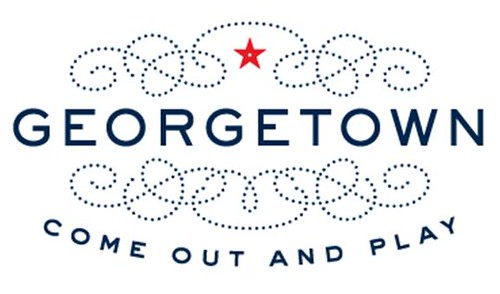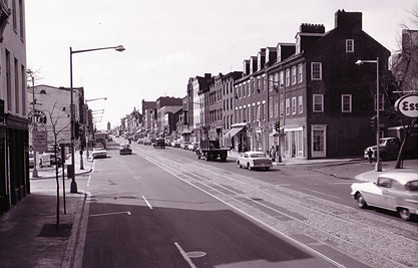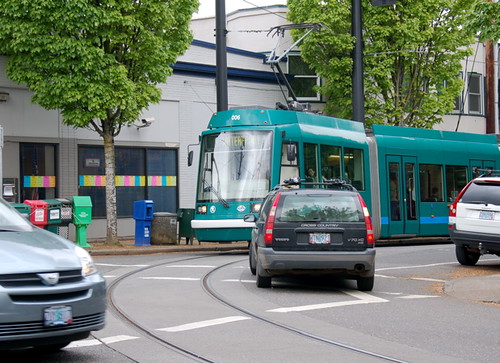Should commercial districts be transit advocates and improve transit accessibility in order to remain relevant in a transit region?

From "Georgetown's New Brand: An Anti-Brand" in the Washington City Paper Housing Complex: "We don't need a slogan. We don't need a brand," said retail broker John Asadoorian, the BID's marketing chair. "We're not trying to be cutesy." Instead, the new website, logo, clean team uniforms, waste receptacles, and other assorted swag will seek to accommodate whatever Georgetown means to everybody who spends time there.
They actually do have a slogan, though: "Washington's neighborhood to come out and play." Branding consultant Neil Archer Roan, also the mind behind NoMa's "Connected" campaign, arrived at Georgetown's more understated message through scores of interviews with Georgetowners who were sometimes skeptical of the need for a branding campaign at all. For the logo, they started with much more historic lettering, but ultimately decided on something more chic and modern (that's Sackers Gothic to you, font geeks).
I've written many times over the years about Toronto's Transit City initiative, which recognized that the City of Toronto 's competitive and equity advantages are best served by improving the breadth and depth of the transit network.
Not to sound like a broken record, but for me it's all about accessibility. One can certainly get to Georgetown via transit, but it's a pain in the ass: either walk across the Key Bridge or or from Foggy Bottom (which means turning into a sweaty mess as this time of year) or idle in hellish traffic on a bus (or a car if that is your thing). It's certainly not the end of the world, but it's a huge pain considering I can just stroll or bike to H Street NE or 8th Street SE or take a short and easy Metro or bike ride Downtown or even to the 14th Street Corridor. Even Pentagon City or the Rosslyn-Ballston Corridor are easier for me to get to than Georgetown. The first requires a pretty easy transfer at L'Enfant Plaza and the second is a one-seat Metro ride. Maybe if I was really into shopping, I might get to Georgetown more often. But for me shopping is something I do as infrequently as possible and only when necessary. And when it is necessary, I want to do it as quickly and conveniently as possible.

Tracks on M Street in Georgetown, with the Esso and Sinclair gas stations on opposite corners, and the tower of the Georgetown Car Barn in the background, circa 1955.DC DOT photo.
Case in point: my wife is starting grdaute school in a few weeks and I wanted to buy her a new Apple laptop. I did not even consider going to the Apple store in Georgetown. From my downtown office, it was so easy to hop on the Yellow Line and travel 4 quick stops to Pentagon City. Even with a transfer at L'Enfant Plaza on the way home, the whole thing was incredibly quick and easy. I think I left my office just after 6 and was home by 7:30. And that includes spending a fair amount of time in the store -- it was crowded and busy. Going to Georgetown would have been a major pain in the ass by comparison.
It may take many years, but I think at some point Downtown will reclaim at least some of its importance as a retail center because of its convenience. To a certain extent, it is already, albeit slowly. National retailers like Apple continue to locate in Georgetown because they don't understand the changes happening in the District and for them Georgetown is "safe." On the other hand, I think anyone arguing that Georgetown is dying is overstating the case. It has certainly changed, but it is not dying. National retailers will probably continue to locate there for the reason I stated above plus the obviously impressive demographics (from a national retailers viewpoint, anyway) but will at the same time also look to locate in other, more easily accessible parts of the District.
In a transit-centric region, stakeholder groups in key DC activity centers like Georgetown that are not directly served by heavy rail transit (subway) primarily, and streetcar/light rail secondarily ought to be key advocates for improving their transit connections, if they want to retain their relevance as a regional shopping and entertainment destination, in a region where a preponderance of people prefer not to drive (especially given the parking issues).
Why aren't the Georgetown BID and the Georgetown Business Association the city's foremost advocates for creating the separated blue line, which would provide at least two subway station connections along M Street.

Proposed 2003 routing for a separated blue line. Washington Post graphic.
Why aren't the Georgetown BID and the Georgetown Business and Merchants Association pushing everyone to get streetcar service on M Street? (which could interfere with my dream to have an in-street cycletrack northbound on M Street).

The Portland streetcar turns left off NW 23rd at Lovejoy from Portland Oregon Daily Photo.
Labels: commercial district revitalization planning, transit and economic development, transportation planning, urban design/placemaking, urban revitalization



0 Comments:
Post a Comment
<< Home